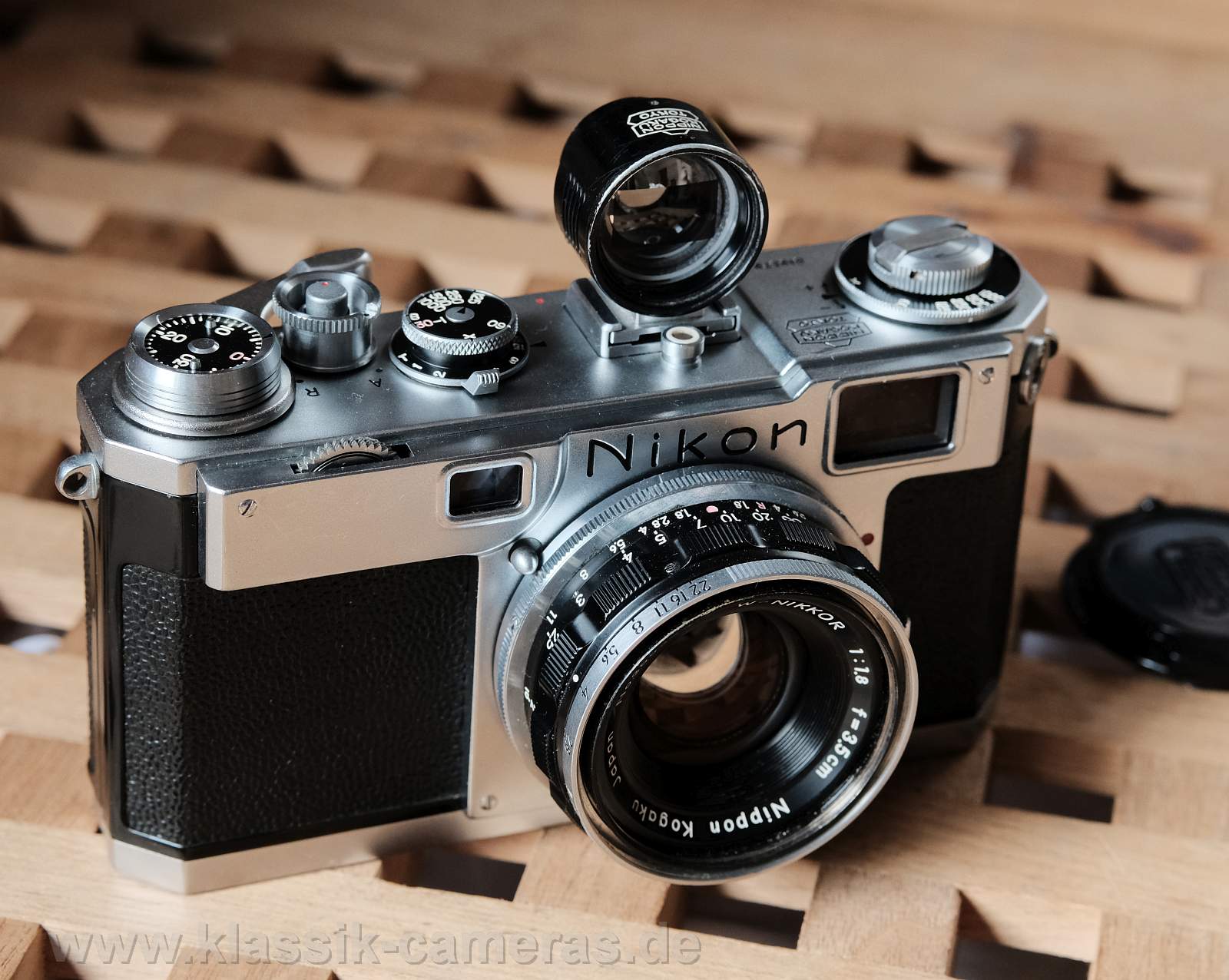NIKON S2 "Chrome dial",
"Black dial" and prototypes
(c) Frank
Mechelhoff
New March 2023
Diese
Seite auf Deutsch

In December 1953 E. LEITZ presented the new LEICA M3. It was high time for a successor to the IIIf
model actually. The Japanese didn't just copied it, they
had improved it, especially CANON: Simple rear door film
loading, viewfinder magnification... Since Oskar Barnack's
death (in January 1936), the Leica had hardly been further
developed.
Now
a show of strength was necessary, and that's exactly what
happened: new lens bayonet, large viewfinder with a large
viewing opening and changeable focal length reflections,
quick-release lever (initially in two strokes), one-piece
speed dial with slow speeds - only the "German",
non-metric speed layout with 1/250, 1/100, 1/50, 1/25, 1/10s, 1/5s, 1/2 s had not yet been refrained from. It became apparent
that these were impractical when the attachable (coupled)
light meter was invented.
However, the M3 was larger and heavier than the IIIf. The weight now roughly
corresponded to the CANON and was (empty) 590 grams, the IIIf
had only weighed 410 grams. Lenses and their caps were
also larger, which was quite noticeable for photographers with
coat pockets and mountaineers. To be sure not to lose any
customers, a IIIg model was added - perhaps the best
"screw-on" of all time, with an enlarged viewfinder. And the M3 didn't have a 35mm
viewfinder as standard -dis just 50, 90 and 135mm. Academic photographers were
still a little disdainful of wide-angle focal lengths back
then. Concentrate
on what was "important for the picture" and telephoto lenses
were preferred - there were hardly any
wide-angle lenses of decent quality and speed... Later (1958) the M2 was
added, with 35mm framelines and lower magnification viewfinder
(0.72 instead of 0.91)
For the Japanese "copyists", in particular NIKON took the M3
very seriously. Their new American importer, Joe
Ehrenreich, traveled to Japan several times, like his
predecessors, and made sure that the wishes of professional
photographers were realized in series. NIKON was by far the
most expensive Japanese camera, prices were about 3/4 of
LEICA. For the
M3, Ehrenreich recommended Nikon "Keep it different!" Don't try to copy them, hold
your line! That
turned out to be wise advice. Direct copies were also
impossible, the M bayonet was patented.
Even before Ehrenreich's takeover, the "NIKON" - Modell S,
the only one offered at that time, essentially the same camera since 6
years - finally was further developed. Like the M3, it has a large
viewfinder eyepiece, viewfinder magnification was 1.0x which
enabled the photographer to take photos with both eyes open.
However,
there was only one frameline, 50mm, and it wasn't parallax
corrected, as LEICA offered, and also not as bright and
clearly visible. Functionally, they were (still) behind LEICA, but had left CONTAX behind. The serial number range of the S2 was from 6135000
to the middle 619xxxx range. So it is amazing that there
is a prototype with the number 6136958 (a bit after production start) with a single speed dial and
integrated flash synchronization. Heaven knows why this was
not put into production. Apparently, an exposure
meter coupling was not provided, as there is no groove or
locking possibility. But the modern, geometric speed lwayout (which
LEICA introduced two years later) was already there. The S2 was also the first
NIKON to offer a 24x36mm film size (instead of 24x32), with
motor connectivity and available in black (by special
order).


It wasn't
until 1957 that NIKON had the next model
ready that could really compete with the
Leica M - the NIKON SP. Since this
also became more expensive, the S2 was kept
available as a subordinate model.

With the SP, the
50mm lenses were now also supplied in a
high-quality black finish (previously the 85/1.5
and the 105/2.5 had been available in
black/aluminium enamel). Since the S2 in
chrome now looked a bit old-fashioned, although
it was only 3 years old, it was given an optical
refreshment as the S2
"Black-dial" (unofficial
name, not advertised or used by Nikon). Speed dial
(still double), frame counter disc,
synchronization time disc and bayonet focus
ring (marked exclusively in feet) were now
black on the camera.
Perhaps
the most beautiful NIKON Rangefinder Camera?



In the
mid-1950s, when
high-quality
cameras were
fast-moving, the
life cycle of
the S2 had come
to an end a year
later: Archrival
CANON had
released the V
and VI models
with 35mm view,
and then the CANON
P
with a focal
framlines for
35, 50 and 100mm
at a time with
parallax
compensation
(and still 1/3
cheaper than
NIKON).

The S2 with
50mm frame
only (an not
much larger
field of view)
required an
auxiliary
finder if used
with a 35mm
wideangle
lens. Since
1956 NIKON
offered a 35mm
brightline
finder - equal
in quality to
the Leitz
SBLOO, but
somewhat
smaller - not
that easy to
locate
presently and
not sold in
large numbers,
because just
one year later
the Nikon SP
was the mainly
sold camera,
which had the
35mm
framelines
inbuild.

Nikon
was forced to
follow suit and,
with a model
change, shared
more of the same
parts with the
SP model. The S3
(1959)
realized
automatic flash
synchronization
and single speed
dial (already
implemented in
the prototype 5
years earlier),
as well as a
larger
viewfinder with
also 3 focal
length
reflections -
simultaneously
visible, albeit
without parallax
compensation -
and also plastic
protection for
eyeglass
wearers,
self-timer and
resetting frame
counter - mostly
from from the
SP.
This ended
the S2 - which
was the camera
in the history
of NIKON wh had
led to full
employment for
the former
military lens
manufacturer and
tranformed them
to a civil
camera maker (~
57.000 units
produced, of
which were ~
15.000 "black
dial") and paved
the way to a
real professional
camera
maker (SP and
F models)...
External Link -- Mike
Eckman : Nikon Rangefinder Prototypes
NIKON S3 "Millenium" Edition
Nikon Main
page
Camera Homepage








